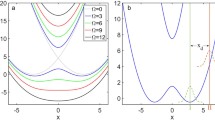Abstract
We consider a trapped two-component atomic Bose-Einstein condensate (BEC), where each atom with three energy-levels is coupled to an optical cavity field and an external classical optical field as well as a microwave field to form the so-called Δ-type configuration. After adiabatically eliminating the atomic excited state, an extended JC-Dicke model is derived under the rotating-wave approximation. The scaled ground-state energy and the phase diagram of this model Hamiltonian are investigated in the framework of mean-field approach. A new phase transition is revealed when the amplitude of microwave field changes its sign.
Similar content being viewed by others
References
R.H. Dicke, Phys. Rev. 93, 99 (1954)
K. Hepp, E.H. Lieb, Ann. Phys. (N. Y.) 76, 360 (1973)
Y.K. Wang, F.T. Hioes, Phys. Rev. A 7, 831 (1973)
J.P. Provost, F. Rocca, G. Vallee, Physica A 85, 202 (1976)
C.M. Bowden, C.C. Sung, Phys. Rev. A 19, 2392 (1979)
C. Emary, T. Brandes, Phys. Rev. Lett. 90, 044101 (2003)
C. Emary, T. Brandes, Phys. Rev. E 67, 066203 (2003)
N. Lambert, C. Emary, T. Brandes, Phys. Rev. Lett. 92, 073602 (2004)
N. Lambert, C. Emary, T. Brandes, Phys. Rev. A 71, 053804 (2005)
X.-W. Hou, B. Hu, Phys. Rev. A 69, 042110 (2004)
C. Emary, T. Brandes, Phys. Rev. A 69, 053804 (2004)
C.F. Lee, N.F. Johnson, Phys. Rev. Lett. 93, 083001 (2004)
Y. Li, Z.D. Wang, C.P. Sun, Phys. Rev. A 74, 023815 (2006)
J. Vidal, S. Dusuel, Europhys. Lett. 74, 817 (2006)
M.A. Alcalde, A.L.L. de Lemos, N.F. Svaiter, J. Phys. A Math. Theor. 40, 11961 (2007)
F. Dimer, B. Estienne, A.S. Parkins, H.J. Carmichael, Phys. Rev. A 75, 013804 (2007)
G. Chen, Z. Chen, J. Liang, Phys. Rev. A 76, 055803 (2007)
D. Tolkunov, D. Solenov, Phys. Rev. B 75, 024402 (2007)
G. Chen, Z. Chen, J. Liang, Phys. Rev. A 76, 045801 (2007)
G. Chen, X. Wang, J.-Q. Liang, Z.D. Wang, Phys. Rev. A 78, 023634 (2008)
K. Baumann, C. Guerlin, F. Brennecke, T. Esslinger, e-print arXiv:0912.3261
D. Nagy, G. Konya, G. Szirmai, P. Domokos, Phys. Rev. Lett. 104, 130401 (2010)
H. Goto, K. Ichimura, Phys. Rev. A 77, 053811 (2008)
O. Tsyplyatyev, D. Loss, Phys. Rev. A 80, 023803 (2009)
M.A. Alcalde, R. Kullock, N.F. Svaiterc, J. Math. Phys. 50, 013511 (2009)
J. Larson, M. Lewenstein, New J. Phy. 11, 063027 (2009)
Q.-H. Chen, Y.-Y. Zhang, T. Liu, K.-L. Wang, Phys. Rev. A 78, 051801(R) (2008)
J.-F. Huang, Y. Li, J.-Q. Liao, L.-M. Kuang, C.P. Sun, Phys. Rev. A 80, 063829 (2009)
A. Öttl, S. Ritter, M. Köhl, T. Esslinger, Rev. Sci. Instrum. 77, 063118 (2006)
F. Brennecke, T. Donner, S. Ritter, T. Bourdel, M. Köhl, T. Esslinger, Nature 450, 268 (2007)
F. Brennecke, S. Ritter, T. Donner, T. Esslinger, Science 322, 235 (2008)
K.W. Murch, K.L. Moore, S. Gupta, D.M. Stamper-Kurn, Nature Phys. 4, 561 (2008)
The so-called “JC” model is the abbreviation for Jaynes-Cummings model (see E.T. Jaynes, F.W. Cummings, Proc. IEEE 51, 89 (1963)), which describes the coherent coupling of a single two-level atom with one mode of the quantized light field by neglecting the anti-resonant terms in the Hamiltonian. Strictly speaking, our current model including N atoms is more related to the Tavis-Cummings model (seeM. Tavis, F.W. Cummings, Phys. Rev. 170, 379 (1968)). For convenience, we keep the well-known name “JC model” here.
M.R. Matthews, D.S. Hall, D.S. Jin, J.R. Ensher, C.E. Wieman, E.A. Cornell, F. Dalfovo, C. Minniti, S. Stringari, Phys. Rev. Lett. 81, 243 (1998)
D.S. Hall, M.R. Matthews, C.E. Wieman, E.A. Cornell, Phys. Rev. Lett. 81, 1543 (1998)
D.S. Hall, M.R. Matthews, J.R. Ensher, C.E. Wieman, E.A. Cornell, Phys. Rev. Lett. 81, 1539 (1998)
J. Metz, M. Trupke, A. Beige, Phys. Rev. Lett. 97, 040503 (2006)
S.-L. Zhu, H. Fu, C.-J. Wu, S.-C. Zhang, L.-M. Duan, Phys. Rev. Lett. 97, 240401 (2006)
Y. Li, C. Bruder, C.P. Sun, Phys. Rev. Lett. 99, 130403 (2007)
C.J. Pethick, H. Smith, Bose-Einstein Condensation in Dilute Gases (Cambridge University Press, Cambridge, 2002)
T. Holstein, H. Primakoff, Phys. Rev. 58, 1098 (1940)
Commonly, when an atomic transition is coupled to only one optical/microwave field, the phase factor of the coupling strength (i.e., Ω here) can be absorbed into the atomic state by redefining the state and thus the coupling strength can be taken to be always “positive”. However, it is not the case if a given atomic transition is coupled to two independent (optical/microwave) fields (or identically coupled to two fields as considered here). In this case, one should not take the both coupling strengths to be always “positive”. In this paper, we consider the coupling strength Ω to be a real value (either positive or negative) for the sake of simplicity (here an opposite sign of Ω may be viewed to denote the opposite direction of the “external field-Ω”, as seen from Eq. (7)).
E. Tiesinga, B.J. Verhaar, H.T.C. Stoof, Phys. Rev. A 47, 4114 (1993)
S. Inouye, M.R. Andrews, J. Stenger, H.-J. Miesner, D.M. Stamper-Kurn, W. Ketterle, Nature 392, 151 (1998)
S.L. Cornish, N.R. Claussen, J.L. Roberts, E.A. Cornell, C.E. Wieman, Phys. Rev. Lett. 85, 1795 (2000)
P.O. Fedichev, Y. Kagan, G.V. Shlyapnikov, J.T.M. Walraven, Phys. Rev. Lett. 77, 2913 (1996)
M. Theis, G. Thalhammer, K. Winkler, M. Hellwig, G. Ruff, R. Grimm, J.H. Denschlag, Phys. Rev. Lett. 93, 123001 (2004)
P. Zhang, P. Naidon, M. Ueda, Phys. Rev. Lett. 103, 133202 (2009)
We here do not adopt the scenario used in reference [20] to address the Mott-superfluid phase transition. It is because such a phase transition may be well defined in the meanfield framework only for ωb = 0.
G.C. Duncan, Phys. Rev. A 9, 418 (1974)
K. Rzazewski, K. Wódkiewicz, W. Zakowicz, Phys. Rev. Lett. 35, 432 (1975)
Author information
Authors and Affiliations
Corresponding author
Rights and permissions
About this article
Cite this article
Li, Y., Zhang, P. & Wang, Z. Extended JC-Dicke model for two-component atomic BEC inside a cavity. Eur. Phys. J. D 58, 379–384 (2010). https://doi.org/10.1140/epjd/e2010-00126-4
Received:
Revised:
Published:
Issue Date:
DOI: https://doi.org/10.1140/epjd/e2010-00126-4




